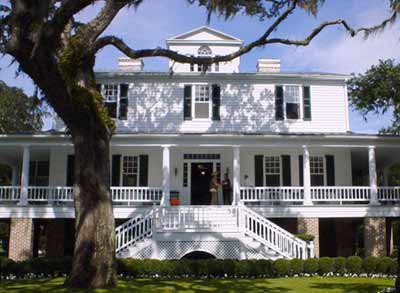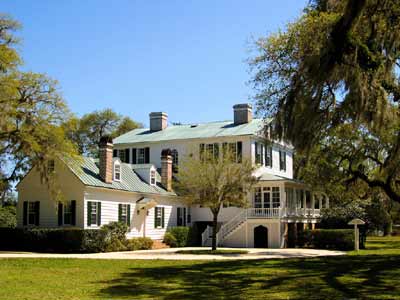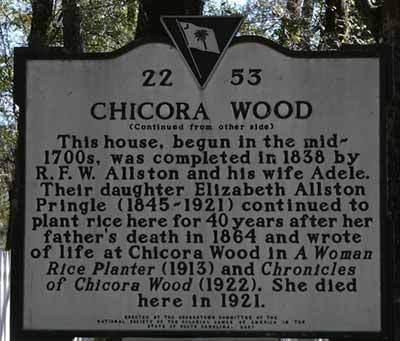Chicora Wood Plantation – Plantersville – Georgetown County
Basic Information
- Location – Pee Dee River, Plantersville, Prince George Winyah Parish, Georgetown County
12 miles northeast of Georgetown on County Road 52
- Origin of name – Matanza was for a place in Cuba thought to have been where some of the Allston slaves may have come from; Chicora Wood from the Chicora Indians that had lived in the area (3, III: 12).
- Other names – Matanza until 1853 (3, III: 12)
- Current status – Privately owned
Timeline
- 1732 – Earliest date of existence (6, p. 335).
John Allston secured a grant for 420 acres on a bluff of the Pee Dee River. Allston would add acreage to the plantation over the years until it totalled 766 (6, p. 335).
- 1748 – John Allston sold 670 acres of the plantation to his son John Allston Jr for £5 (6, p. 335).
- Mid 1700s – Jamie Constance shares, "There is very convincing architectural archeology evidence that the smaller wing on the north side was a flanker of a mid 1700s house that burned sometime around 1798. This flanker survived the fire and was attached to the new section which was built before 1809. The brick foundation of the earlier house along with burned embers are still in the ground." (9)
- 1750 – John Allston Sr. died. In his will, son John Allston Jr. would receive his main plantation Turkey Hill Plantation if he transferred ownership of the smaller plantation (Chicora Wood) to brother Josias Allston. Before this transfer could be done, John Allston Jr. too died. Josias inherited Turkey Hill and the other plantation was willed to John Allston Jr.'s children, Martha Allston Young and Eleanor Allston Simons (6, p. 335).
- 1764 – Benjamin and Martha Allston Young sold their share of the plantation to Martha's sister's husband, Peter Simons (6, pp. 335, 336).
- 1771 – Peter Simons sold the plantation to cousins and brother-in-laws, Richard and Benjamin Waring (6, p. 336).
- 1772 – Richard Waring purchased Benjamin's part of the plantation (6, p. 336).
- 1777 – Richard Waring sold the property to his brother, John Beamor Waring. John purchased two adjoining tracts the same year to bring the size of the plantation up to 922 acres (6, p. 336).
- 1779 – John Beamor Waring sold the tract to Alexander Rose and John Torrens (6, p. 336).
- 1780 – John Torrens died and his will stipulated the plantation was to be sold. Alexander Rose would purchase this part of the plantation from Torrens' heirs, wife Elizabeth and son William Torrens (6, p. 336).
- 1782 – The US government deemed Alexander Rose loyal to Britain and all his property was confiscated. Rose petitioned that he was not a Tori and was granted his land back after a fine of 12% was levied (6, pp. 336-337).
- 1784 – A plat of the plantation was drawn noting it to be 608 acres at this time and called Mantanza. This plat was mysteriously commissioned by John Holmes who had no ownership in it (6, pp. 336-337).
- 1801 – Alexander Rose died. His estate's executors conveyed the 922 acre Mantanza Plantation to Benjamin Allston, grandson of the original owner, John Allston Sr. (6, p. 337).
- 1807 – Benjamin Allston died and left the plantation to young sons William and Robert (6, p. 337).
- 1809 – House built sometime before this year (9).
- 1819 – Benjamin Allston's widow moved with her sons, William and Robert, to Mantanza Plantation to manage the property until the boys were old enough to (6, p. 338).
- 1823 – William Allston died leaving his half ownership of Mantanza jointly to his brothers Joseph and Robert (6, p. 338).
- 1832 – Robert Francis Withers Allston purchased his brother Joseph's quarter ownership in the plantation to become sole owner (6, p. 338).
Robert F.W. Allston held many political positions, including governor of South Carolina.
- 1838 – The house enlarged and remodeled by Robert Francis Withers Allston (9).
- 1853 – The Allstons changed the name of Matanza Plantation to Chicora Wood Plantation (3, III: 12).
- 1864 – Robert Francis Withers Allston passed away leaving the plantation to his wife Adele Petigru Allston. Allston had accumulated many plantations by the time of his death but the devastation of the Civil War and heavy taxes, Chicora Wood was the only plantation Adele was able to retain ownership of. When Adele Allston and her daughter Elizabeth returned to Chicora Wood after the war, they found the house in shambles. Federal officers had told the former slaves the Allstons would not be returning and the slaves could take over the house and remove its contents (6, p. 339) (8, pp. 329, 506).
- 1869 – Adele Allston, with the help of her daughter and a cousin in New York, was able to gather the funding to repair the house and purchase supplies to begin planting again (6, p. 339).
- 1896 – Adele Petigru Allston died and the plantation had to be sold to settle debts of her estate. Daughter Elizabeth "Bessie" Waites Allston Pringle was able to purchase it (6, p. 339) (8, p. 506).
- 1921 – Elizabeth "Bessie" Waites Allston Pringle passed away and the plantation became part of her estate (6, p. 340).
- 1926 – Elizabeth's younger sister, Jane Hill, and nephew, Elias Vanderhorst, sold Chicora Wood on behalf of the estate to Duncan Cameron Waddell (6, p. 340).
- ? – Duncan Cameron Waddell died and his widow, Vaugh Waddell, inherited the plantation (6, p. 340).
- 1961 – Vaugh Waddell passed away and left Chicora Wood Plantation to nephew T.W. Andrews who did reside there for several year (6, p. 340).
- 1984 – Chicora Wood was purchased by Jamie W. and Marcia Constance whom immediately began a major two and a half year restoration. Grass turf was being grown for commercial sale (6, p. 340) (9).
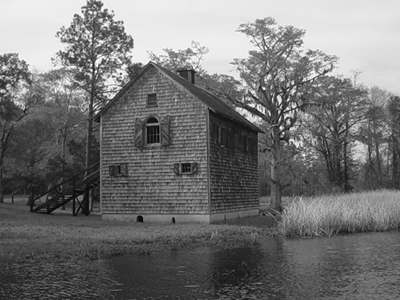
— Chicora Wood Rice Shipping House © R. Myers Truluck, Jr., 2005 —
(Do Not Use Without Written Consent)
Land
- Number of acres – 420 in 1732; 766 in 1738; 670 in 1748; 922 in 1777 and 1801 (6, pp. 335-336)
- Primary crop – Rice
- Primary crop today – Grass turf
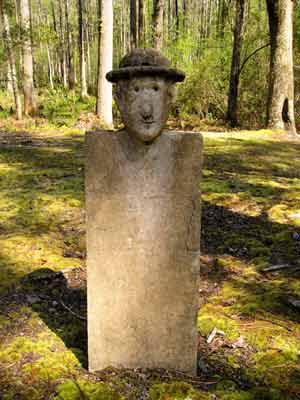
— Marker in Slave Grave at Chicora Wood Plantation —
— © Brandon Coffey, 2009 —
(Do Not Use Without Written Consent)
Slaves
- Number of slaves – 590 in 1864 (8, p. 329)
Buildings
- There are several outbuilding on the property including the original kitchen, smoke house and carriage house (1, p. 5).
References & Resources
- National Register of Historic Places
– Nomination form - PDF - submitted in 1972
– Photographs, architectural overview
- 30-15 Plantation File, held by the South Carolina Historical Society
- Claude Henry Neuffer, editor, Names in South Carolina, Volume I through 30 (Columbia, SC: The State Printing Company)
 Order Names in South Carolina, Volumes I-XII, 1954-1965
Order Names in South Carolina, Volumes I-XII, 1954-1965
 Order Names in South Carolina, Index XIII-XVIII
Order Names in South Carolina, Index XIII-XVIII
- William P. Baldwin, Jr., Plantations of the Low Country; South Carolina, 1697-1865
(Greensboro, NC: Legacy Publications, 1987)
 Order Plantations of the Low Country; South Carolina, 1697-1865
Order Plantations of the Low Country; South Carolina, 1697-1865
- J. H. Easterby, The South Carolina Rice Plantation as Revealed in the Papers of Robert F. W. Allston (Southern Classics Series)
(Columbia, SC: University of South Carolina Press, 2004)
- Suzanne Cameron Linder and Marta Leslie Thacker, Historical Atlas of the Rice Plantations of Georgetown County and the Santee River
(Columbia, SC: South Carolina Department of Archives and History, 2001)
 Order Historical Atlas of the Rice Plantations of Georgetown County and the Santee River
Order Historical Atlas of the Rice Plantations of Georgetown County and the Santee Riverpp. 335-340
- Catherine Campart Messmer, South Carolina's Low Country - A Past Preserved Text (Orangeburg, SC: Sandlapper Publishing, 1988)
- George C. Rogers, Jr., The History of Georgetown County, South Carolina
(Spartanburg, SC: Reprint Company, 1990)
 Order The History of Georgetown County, South Carolina
Order The History of Georgetown County, South Carolina - Information contributed by owner Jamie W. Constance.
Notes
- South Carolina Plantations extends a special thanks to Mr. Jamie W. Constance for his invaluable assistance verifying and contributing to the information on this page and for being a faithful guardian of Chicora Wood.

